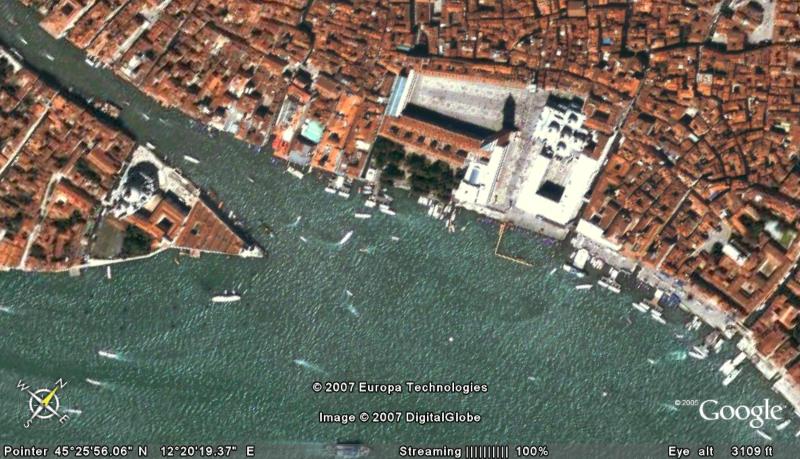In Venice, there are about 120 islands, 150–180 canals and 400 bridges. The city was allegedly founded in AD 452, when the inhabitants of Italian cities north of the lagoon took refuge on the islands of the lagoon from the tribes that invaded Italy.

Piazza San Marco

Looking into the Piazza: The Colonne de Marco E Todaro (Columns of Mark and Theodore), erected in 1180 at the entrance to the Piazza San Marco. The left one is Saint Theodore of Studium on a crocodile (Todaro in dialect, the first patron of Venice); to the right is the winged lion of Saint Mark (present patron of Venice). This lion is controversial as the book (the Bible) lies open but the front feet of the lion rest on it, indicating that the lion/Venice will not accept the dominance of the church: Venice was excommunicated at least twice by the Popes.
One of the Basilica domes is visible on the right, behind the Palazzo Ducale.

Looking down onto Piazza San Marco. You can see the shadow of the Campanile in the Square.

(Picture from a vaporetto (water bus) as we motored to Piazza San Marco)

San Marco with his foot on the Bible (this was a ferryboat logo!)

The Biblioteca Marciana and the entrance to the Piazza and the Column of San Marco

Marco E Todaro (Mark and Theodore)

The risers are placed out when the higher than normal tides (alta aqua) are expected. The building beyond the columns
is the Biblioteca Marciana and the Santa Maria della Salute is to the left in the distance (across the Grand Canal).
Views from the Campanile

The Campanile at Piazza San Marco is 315 feet tall. The Biblioteca Marciana is in front of the clock tower.
(Picture from the Symphony as she sailed into Venezia.)

The Basilica di San Marco from up in the Campanile. The church is built in the shape of
an equal-armed or Greek cross, with the large dome of about 42 ft in diameter over
the central crossing and the slightly smaller domes over each of the four arms.

The Ducal Palace (Palazzo Ducale)

The Campanile (clock tower) was built between 874–1150 a.d. and reconstructed after it collapsed in 1902. The building to the left front of the Campanile is the Biblioteca Marciana. The Ducal Palace (Palazzo Ducale) is in the center, at the right of the entrance to the Piazza San Marco. The “New Prison” (Prigioni Nuove) is just visible to the far right.

The Ducal Palace at Piazza San Marco.
The left edge is wrapped in painted tarp, under which rehabilitation is being done.
The column of Venice’s patron saint, Saint Mark (San Marco) is visible on the left.

The Palazzo Ducale on the left, with the Ponte di Sospiri (Bridge of Sighs) leading to the Prigioni Nuove (the “New Prison”) on the far right. The canal is called Rio de Palazzo d. Paglia. Note the row of gondolas in front of the Palace. The red-topped boat is a vaporetto (“water-bus”); the white-roofed, glass-fronted building is the San Zaccaria (Saint Zacchary) “bus-stop.”

The front of the Palazzo Ducale. The present building (c.1345–1438) is considered a definitive example of Venetian Gothic architecture.

The Palazzo Ducale. The covering on the right hides repair and rehab work.

The Palazzo Ducale from up in the clock tower (Campanile).
The upper walls are of white and pink marble lozenges set in diagonal patterns.
 Looking up the canal called Rio de Palazzo d. Paglia.
Looking up the canal called Rio de Palazzo d. Paglia. The Ponte di Sospiri (Bridge of Sighs), from which sentenced prisoners
saw their last view outdoors as they were marched into the New Prison.

Looking down/out the canal called Rio de Palazzo d. Paglia.

Same view, one bridge further up the Rio de Palazzo d. Paglia.
The Basilica di San Marco

The Basilica di San Marco, started about AD 828, reconstructed after a fire in 976, and rebuilt between
1047 and 1071, is considered an outstanding example of Byzantine architecture.
(The Campanile is out of frame to the direct right.)

The Basilica di San Marco was built around 828 to hold the holy relic, the bones of Saint Mark, which were stolen and smuggled out of Constantinople under a shipment of pork – as the Arabs wouldn’t likely inspect the cargo packed there!


The original horses, made during the days of Alexander the Great (4th century b.c.), were taken to Rome by Nero, to Constantinople by Constantine, to Venice by crusaders, to Paris by Napoleon, and back to Venice when Napoleon fell. The four horses are replicas; the originals were taken indoors out of the acidic air.

Alta Aqua
 Saint Mark’s Square is innundated more and more often. We happened to be there
Saint Mark’s Square is innundated more and more often. We happened to be there near a full moon, so we got to see the 8″–10″ of water filling the Square.

Gondolas moored next to the Piazza de San Marco. The actual edge of the pavement is
outside the lamp posts. The Santa Maria della Salute is visible off to the right.
The Santa Maria della Salute

The customs house and the Santa Maria della Salute. The canal splitting off in front is
the (southern) entry to the Grand Canal. Picture from up in the Campanile.

The Santa Maria della Salute was built in the 1630s in gratitude for the ending of a plague.


Ponte Rialto



The view downstream from below the bridge from below the Ponte Rialto (Rialto Bridge)








